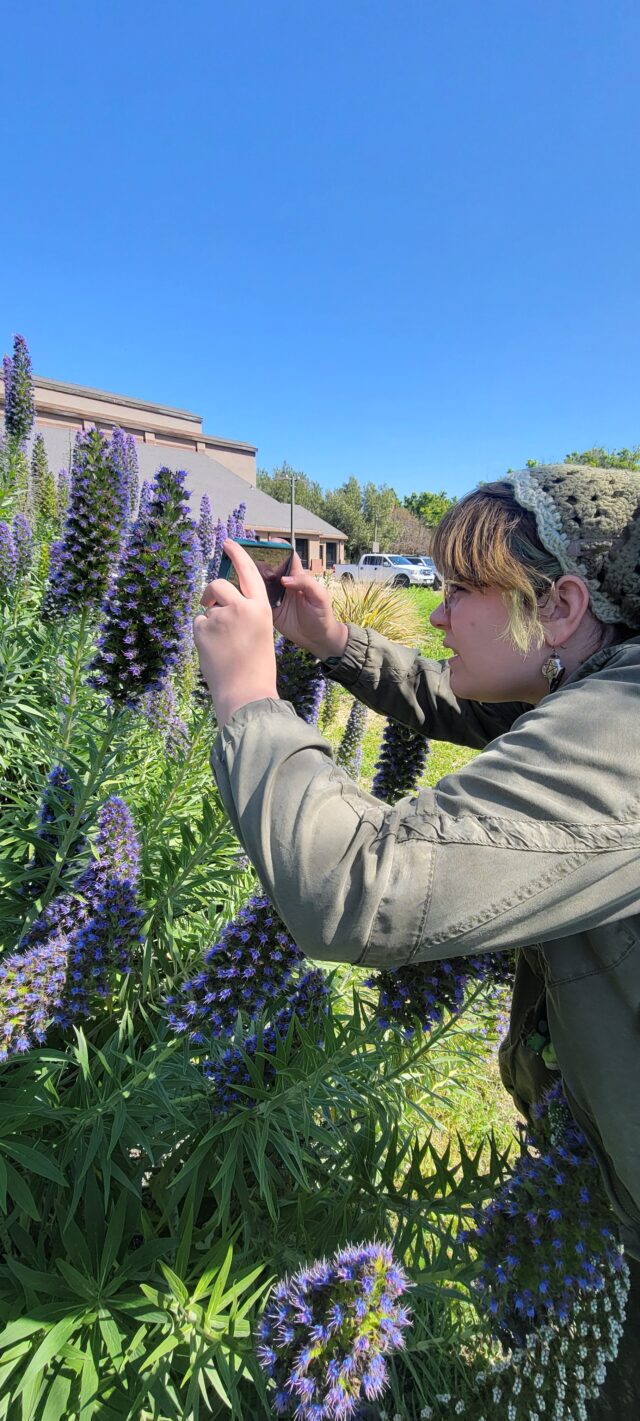
April is California Native Plant month and campus is blooming. Around the DeRicco building, patches of bright orange California poppies are springing up, and the California asters at the Horticulture Center’s gardens have opened their delicate petals. These California native plants tella story of local history and conservation.
Delta College is no stranger to preservation, with even the buildings and campus location named after important founders and activists, it’s no surprise that the Horticulture Center would have already taken steps to support Native plant life in “The Meadow”, the Horticulture Center’s Native Pollinator Habitat.
“The idea is that we’re trying to create a habitat for the monarch butterfly,” said Associate Professor of Agriculture Tina Candelo-Mize oversees much of The Meadow’s management. Monarch butterflies, as well as the species of bee native to the area, that are cared for on campus by Professor of Biology, Dr. Paul Ustach.
Pollinator species like bees and butterflies are important to local ecosystems because they move pollen from flower to flower, so plants can grow fruit.
The Meadow, located across from the science and math building, off Burke-Bradley road, can be easily identified by the iron windmill that stands in the middle of the field.
Candelo-Mize said that plans for the Meadow are moving forward, as more native Californian plants are projected to be placed in the habitat. Currently, plants like ceanothus, a deep blue flowering shrub, sometimes known as the California Lilac, and Pride of Madeira, a subshrub that grows 20-inch conical clusters or purple flowers, populate the habitat, and draw a surprising amount of the native bees on campus. However, there have yet to be any official sightings of the Monarch butterfly on campus, although Candelo-Mize reported a potential sighting of two orange butterflies which might have been, but were never officially confirmed to be, Monarchs.
It’s more than just butterflies and bees, said Candelo-Mize, the habitat is also supportive of moths, wasps, lizards, birds, squirrels and other native critters.
To protect the species of the habitat, the Horticulture Center does not allow the use of pesticides within 300 feet of the habitat.
President of the Horticulture club, Ajani Young, said that the environmental impact of a healthy native ecosystem supports more than just the pollinators “a healthy balance for the land by preventing erosion, reducing wildfire spread, or organically filtering water.”
The Meadow is insular and quiet, and previous horticulture intern Janet Good said that students often visit for a peaceful place to study.
The Meadow isn’t the only place on campus to see native plants. The Native Plant walk near the DeRicco Student Services building supports the growth of more Native plant life, like poppies and large coastal live oaks. Giant Sequoia trees grow near the Dolores Huerta Plaza.
The Native Plant Walk next to DeRicco Student Services building, which extends to the Pacific frontage road hosts many of these and other native Californian plants. Associate Professor of Ethnic and Native American Studies Nia Gregory guides the tour. Gregory knows the importance these native plants have on the history of indigenous cultures.
“Many indigenous cultures rely on native plants for food, medicine, and materials, and they hold deep spiritual connections to them,” said Gregory.
“In urban areas, native plants can contribute to a sense of place and identity, creating landscapes that are both ecologically and culturally meaningful,” said Gregory.
Those involved with native ecosystem preservation at the Horticulture Center believe native plants are integral to the native ecosystem as well as the preservation of local history and indigenous culture.
But preservation isn’t something that should be left to the experts; with some research, anyone can get involved.
Candelo-Mize said it’s important to use an integrative approach to preservation by including native and non-native plants in preservation efforts. Even steps as small as choosing what to plant in a personal garden can make an impact.
“Someone goes to a nursery and they’re looking for something to plant in their garden, they can pick up a California native plant” said Candelo-Mize, who also suggested learning the indigenous plant names is just as important as learning the scientific categories.
Young said supporting native plant life can look like replacing invasive species for similar native or naturalized plants. This requires research of course, which can be conducted with trusted resources like the California Native Plant Society at cnps.org, or by visiting the Horticulture Center and native plant walks, on and off campus.
Being involved means more than passive observation and research; people can put plants in the ground, but Young offers a stern warning.
“Always be sure that it’s in the right place; just because it’s a native to California, doesn’t mean it’s native to the [Central] Valley,” said Young, pointing out the vastness of the approximately 6,500 plant species growing across California in the many different environments that span the large state.
It is important to know what is being planted, and where it is being planted. Planting edible native plants for instance, should come with the knowledge that many of these plants require preparation, such as acorns, which can be milled into a flour, but cannot be consumed safely without preparation.
“Know what you’re eating before you shove it in your mouth,” said Candelo-Mize, who knows plenty about the edible native plants growing on campus, like the California Currant.
Finally, Gregory listed ways that students and locals can get involved and support local wildlife. More than planting a garden, there’s power in knowledge and observation.
“Increase your awareness by attending informational events and workshops,” said Gregory.
“Preserve existing native plant habitats by minimizing disturbances. Avoid trampling on areas with native plants and encourage others to do the same.”
Gregory also pointed out that purchasing native plants at plant sales, like those held at the Horticulture Center every 2nd and 4th Friday of each month, can provide plants for personal gardens and helps to pay for important agricultural information.
To find out more check out the California Native Plant Walk near the DeRicco building, or call or visit cnps.org’s California Native Plant event Calendar for other local events.



